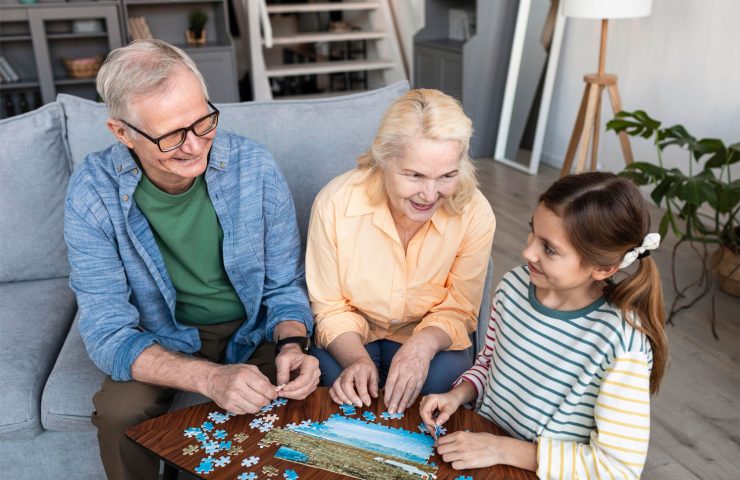
When a brain, or in this case your grandchild, is given time to puzzle over a problem, pathways in the brain strengthen. Creative problem-solving is commonly used in education to help children learn in a way that prepares them for today’s world – a world very different from when we were growing up or raising our own children. This article uses research to demonstrate the importance of creativity in the early years.
The first part of creativity centres around the ability of the brain to coordinate all the sensory messages coming in from the body. The technical name for this is ‘multisensory brain integration’. In a nutshell, this means information from the body arrives into the brain via our senses – sound (ears), sight (eyes), taste(tongue), touch (skin), balance (inner ears) and movement (muscles and joints) – and the brain then interprets the incoming information, analyses it and sends out a response. Without this process, the brain cannot think clearly, nor is it able to learn new things or be creative1.
When a baby is born, the brain is not yet practised at multisensory integration but, with experience and interaction with the world, the brain becomes highly proficient at this task. It is therefore very important for a developing brain to be engaged in many sensory-motor activities in the early years. A study completed in the Netherlands 2 showed that multisensory integration is lost when the brain suffers a traumatic brain injury. When this happens, the child can have increased difficulties managing their life, both physically and cognitively. However, children deprived of good quality sensory-motor stimulation can also have similar difficulties. The best way to help children develop multisensory integration is to be active and use as many senses as possible. This way the brain reaches a state of multisensory integration.
Brain integration was shown to be a key component in adults with high levels of creativity 3. When asked to solve problems using innovation and creativity, Swedish researchers found that those individuals with higher levels of brain integration scored higher on a range of skills. These skills included verbal flexibility, conflict-resolution, moral reasoning and manageability. People with higher levels of brain integration felt more in control, had greater speeds of processing as well as scored higher in cognitive flexibility and originality when confronted with an old situation that needed a new solution. These were Swedish product development engineers, but your grandchildren need the same set of skills. Every time you engage your grandchild in a problem-solving task, you are testing and stretching their levels of creativity.
Giving children time is something that is explored in Grandparenting Children. When it comes to creativity, it is particularly important that children are often left with the problem they are trying to solve. A trick to learn is not to give answers to things too quickly. Instead, give clues that there might be a different solution. Here is an example of how to do this.
A granddaughter told her grandmother that all cats were girls, and all dogs were boys. When asked why this might be so, the child said that it was because cats are little, gentle and soft (clearly, she had not met Scarface Claw from Hairy McCleary) and dogs are rough and boisterous. Now at this point, the grandmother could have given the child a lesson in the facts of life. But the child would not believe Grandma’s ‘reality’ “How could Grandma think that?” and this could have a detrimental effect on the child’s later relationship with her grandparents. Instead, the grandmother did not say anything. Later on, she was in a situation where they were looking at dog pictures. First, they found a picture of a little dog.
GM: “Do you think that dog is a boy or a girl?”,
Child: “A Boy”,
GM: “But it is little, gentle and soft”,
Child: “Oh well, they can be little and soft sometimes”.
Then they looked at a picture of a dog with puppies.
GM: “Do you think this dog is a girl or a boy?”
Child: “Well, it could be the Dad!” then there was a pause. “Grandma, can dogs be girls and boys?”
The conversation proceeded to wander around this topic, still with the child taking the lead.
This is the best way for children to learn; through discovery. They have a theory, in this case, “all dogs are boys”, and then some new information challenges that theory so that they have to reassess the original theory and possibly arrive at a different solution. But the child is not forced to view the world from someone’s perspective. These conversations grow brains, which in turn grow creative problem-solvers. We need many of them to help solve the multitude of challenges our planet is facing.
Creativity starts when children are born, movement wires the hardware (brain) and then sensory experiences build strong connections in the brain. When the child has language, the quality of the conversations can influence the type and depth of learning that takes place. When you know how to do this, you can be a positive force in developing the creativity of your grandchildren. There are more practical ideas in Chapter 8 of our book, Grandparenting Grandchildren.